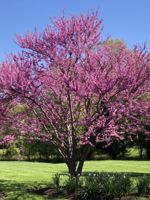Mon-Fri 9am - 5pm Mountain time
Japanese Maple vs Eastern Redbud
Acer palmatum
Cercis canadensis
NOT AVAILABLE THIS SEASON - MIGHT RETURN
Japanese Maple is one of the most popular accent maples. Its long, fingered lobed leaves can be variegated in the summer with lighter shades of green, red, or even purple. Its autumn colour is a brilliant red that is uncommon in most plants, which adds nice contrast to your yard when planted near other trees.
The Japanese Maple is a diverse variety, there are over 1,000 cultivars with different sizes, shapes, and colours.
This species is extremely popular with bonsai enthusiasts.
The Eastern Redbud is known for the pea-like pink buds that emerge in clusters on the bark, embellishing the tree in stunning flowers. They have a longer bloom time, sometimes for two to three weeks before the heart-shaped leaves emerge for the summer. Inedible pods emerge that turn brown in the summer, this tree is a part of the bean family.
Native to the Eastern North America. The Eastern Redbud can tolerate acidic and alkaline soil. Plant this as a beautiful understory species or shaded residential yard or garden. The bright pop of color will make an attractive ornamental tree.

